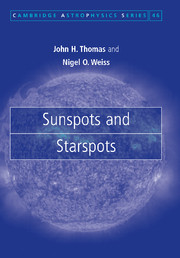Book contents
- Frontmatter
- Contents
- Preface
- 1 The Sun among the stars
- 2 Sunspots and starspots: a historical introduction
- 3 Overall structure of a sunspot
- 4 Fine structure of the umbra
- 5 Fine structure of the penumbra
- 6 Oscillations in sunspots
- 7 Sunspots and active regions
- 8 Magnetic activity in stars
- 9 Starspots
- 10 Solar and stellar activity cycles
- 11 Solar and stellar dynamos
- 12 Solar activity, space weather and climate change
- 13 The way ahead
- Appendix 1 Observing techniques for sunspots
- Appendix 2 Essentials of magnetohydrodynamic theory
- References
- Index
8 - Magnetic activity in stars
Published online by Cambridge University Press: 28 October 2009
- Frontmatter
- Contents
- Preface
- 1 The Sun among the stars
- 2 Sunspots and starspots: a historical introduction
- 3 Overall structure of a sunspot
- 4 Fine structure of the umbra
- 5 Fine structure of the penumbra
- 6 Oscillations in sunspots
- 7 Sunspots and active regions
- 8 Magnetic activity in stars
- 9 Starspots
- 10 Solar and stellar activity cycles
- 11 Solar and stellar dynamos
- 12 Solar activity, space weather and climate change
- 13 The way ahead
- Appendix 1 Observing techniques for sunspots
- Appendix 2 Essentials of magnetohydrodynamic theory
- References
- Index
Summary
If we were to observe the Sun from the distance of α Centauri (4.3 light years), we would not be able to resolve its spots directly or to detect luminosity variations as they came and went; nor could we measure its magnetic field. Although we naturally expect that there should be analogues of solar magnetic activity on lower main-sequence stars that are similar to the Sun (Tayler 1997; Rosner 2000), we can only detect this activity through indirect measurements of other effects that are known to be associated with active regions on the Sun itself. These effects include X-ray emission from stellar coronae, optical and radio emission from flares and enhanced chromospheric emission, notably in the H and K lines of singly ionized Ca II (Wilson 1994; Schrijver and Zwaan 2000). As we shall see, there are indeed also some stars that are much more active than the Sun, whose magnetic fields can be measured directly; such stars also exhibit substantial variations in luminosity that can be ascribed to the presence of starspots on their surfaces.
Stellar Ca II emission
The most widely used indicators of stellar magnetic activity are the emission cores of the Ca II H and K absorption lines. On the Sun, Ca II emission forms a chromospheric network, first observed by Hale (Bray and Loughhead 1974), which corresponds to the magnetic network that outlines supergranules in the photosphere. This emission could be detected if the Sun were viewed from a nearby star, and the cyclic variation of solar activity would also be apparent, as can be seen from Figure 8.1.
- Type
- Chapter
- Information
- Sunspots and Starspots , pp. 150 - 157Publisher: Cambridge University PressPrint publication year: 2008

